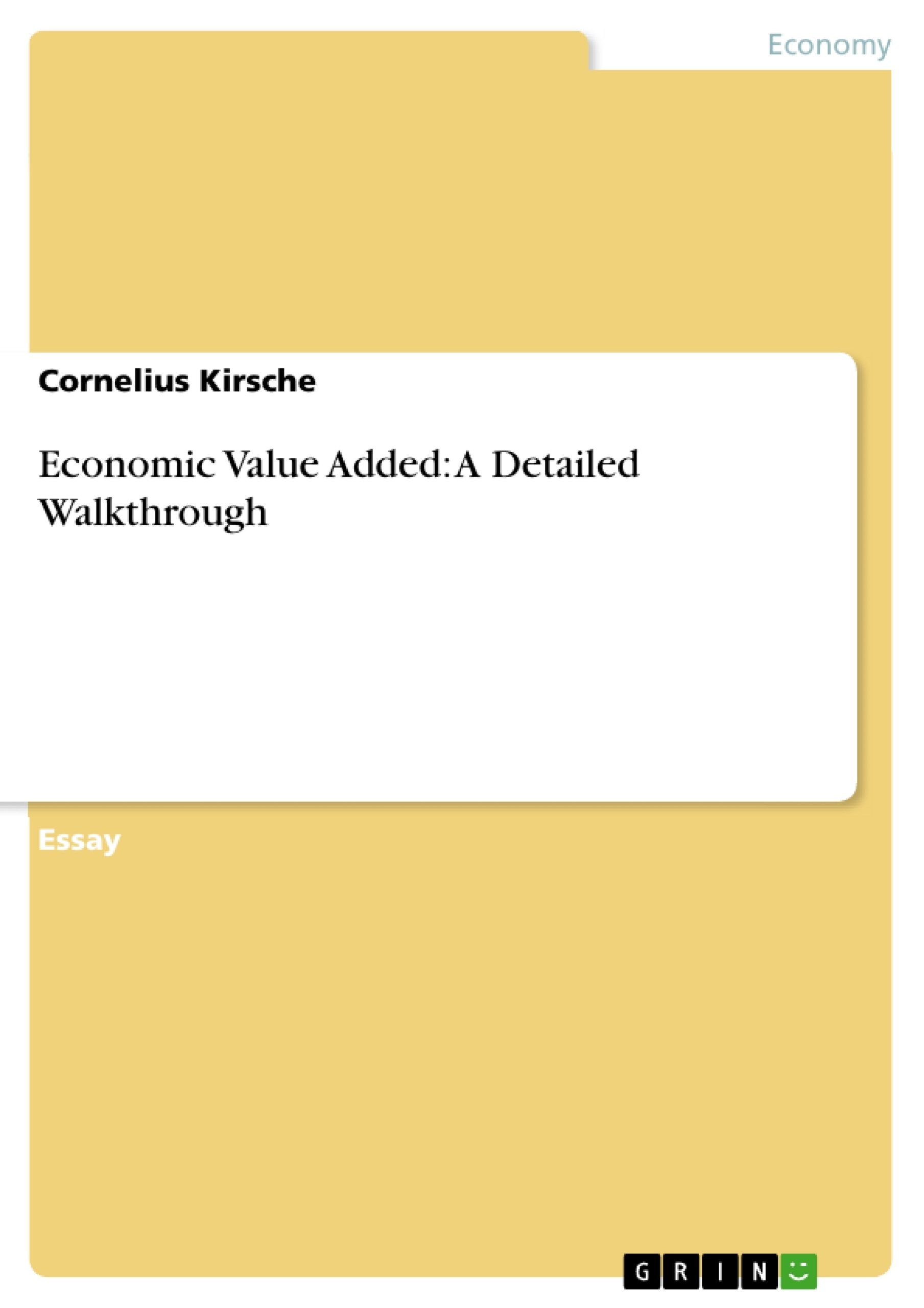In the past, key financial instruments were focusing on concepts like the return on investment, return on equity and return on capital employed. However, within recent years, the flaws of the named ratios made it difficult to thoroughly rely on such figures any longer. As one key drawback connected to those solely finance-related ratios was that all non-financial aspects are missed out on. Further, the economic value creation was not respected in past models. EVA®, economic value added, is a concept on the rise that counteracts the flaws of recent financial ratios. By accounting for both the capital charges for investors and creditors, it allows a more sophisticated look into the value creation of a company. However Stern Steward & Co, who founded EVA®, give recommendations, so called adjustments, in order to make EVA® even more effective as it is without. As economic decision are not only covered by introducing a new ratio, it is important to contrast and to integrated EVA® to other frequently used financial models. Here, the net present value calculation is used most when evaluating on whether or not to take on a project. Now, the author shows that EVA® even can be used for net present value calculations, which is usually done by taking into consideration future cash flows. Further, economic profit is not all a modern business has to care about. In this respect, cash management has evolved in becoming a crucial cornerstone in financial management. Hence, the author has compared the cash conversion cycle to the EVA®. The questions is, does liquidity also affect the EVA® result? Finally, the author concludes on whether or not EVA® can be regarded as ‘the one financial ratio’ an how it interplays with other important models used in modern companies.
Inhaltsverzeichnis (Table of Contents)
- 1. INTRODUCTION
- 2. EVA - THE ONE PROFIT FIGURE.
- 2.1 CALCULATION OF ECONOMIC VALUE ADDED
- 2.2 THE BENEFITS AND DRAWBACKS OF EVAⓇ.
- 2.2.1 Benefits of applying EVAⓇ
- 2.2.2 Pitfalls of applying EVA®
- 3. THE RELATIONSHIP BETWEEN ECONOMIC VALUE ADDED AND DISCOUNTED CASHFLOW MODEL.
- 4. THE RELATIONSHIP BETWEEN ECONOMIC VALUE ADDED AND CASH CONVERSION CYCLE.
- 5. CONCLUSION.
Zielsetzung und Themenschwerpunkte (Objectives and Key Themes)
This paper explores the concept of Economic Value Added (EVAⓇ) as a financial metric for evaluating business performance. It analyzes the advantages and disadvantages of EVAⓇ, highlighting its potential to provide a more comprehensive view of value creation compared to traditional financial ratios. The paper examines the relationship between EVAⓇ and other financial models, particularly discounted cashflow models and the cash conversion cycle.
- Economic Value Added (EVAⓇ) as a performance metric.
- The benefits and limitations of applying EVAⓇ.
- The relationship between EVAⓇ and discounted cashflow models.
- The relationship between EVAⓇ and the cash conversion cycle.
- The potential of EVAⓇ as a comprehensive financial ratio.
Zusammenfassung der Kapitel (Chapter Summaries)
Chapter 1: Introduction This chapter sets the stage for the paper, introducing the concept of EVAⓇ and its relevance in the context of traditional financial ratios. It highlights the shortcomings of traditional ratios and argues for the need for a more comprehensive approach to value creation.
Chapter 2: EVA - THE ONE PROFIT FIGURE. This chapter delves into the calculation of EVAⓇ, explaining its components and the methodology used. It then explores the benefits and drawbacks of applying EVAⓇ, highlighting its potential to provide a more accurate assessment of value creation while acknowledging its limitations.
Chapter 3: THE RELATIONSHIP BETWEEN ECONOMIC VALUE ADDED AND DISCOUNTED CASHFLOW MODEL. This chapter explores the connection between EVAⓇ and discounted cashflow models, examining how EVAⓇ can be incorporated into project valuation and analysis.
Chapter 4: THE RELATIONSHIP BETWEEN ECONOMIC VALUE ADDED AND CASH CONVERSION CYCLE. This chapter examines the relationship between EVAⓇ and the cash conversion cycle, exploring how liquidity management can affect EVAⓇ results.
Schlüsselwörter (Keywords)
The paper focuses on the key topics of Economic Value Added (EVAⓇ), financial ratios, liquidity management, and project valuation. It analyzes the advantages and drawbacks of EVAⓇ and investigates its relationship with other essential financial models, aiming to provide a comprehensive understanding of its potential as a tool for decision-making and performance evaluation.
- Citar trabajo
- Cornelius Kirsche (Autor), 2013, Economic Value Added: A Detailed Walkthrough, Múnich, GRIN Verlag, https://www.grin.com/document/209726



